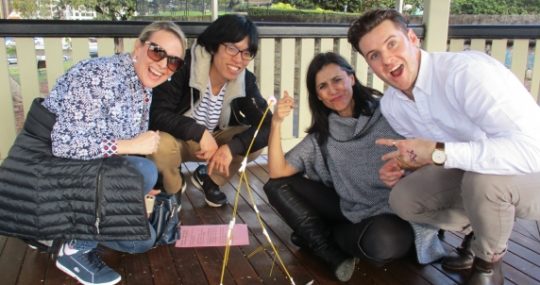Team Building Icebreaker Games for Introverts and Skeptics
How to make team building better for introverts, plus loads of great icebreaker ideas
Some people are always up for a bit of fun, whilst others approach “team building exercises” with dread. They find the forced participation, requirement to “share” or general rowdiness just horrible.
In fact, a recent thread for suggestions for icebreakers included comments like “kill me now”, “just don’t do any”, “there’s a special place in hell for people that think these are a good idea” and “I just point blank refuse to do anything like this”.
As a team building professional, these comments are like a stab to the heart. Whilst I acknowledge that some people despise team activities, if you can overcome this resistance investing time in building rapport pays off ten fold. However, as leaders, let’s be considerate and identify some activities that are not objectionable to introverts and sceptics.
.
Well chosen icebreakers and games accelerate your efforts to build a positive culture by stimulating cooperation, participation and comfort within the group. Plus they can be a lot of fun.
So, why take time out from a heavy agenda for some “game time”?
- Create a positive mood.
- Help a new group get to know one another.
- Help new team members to integrate.
- Help people feel comfortable together.
- Encourage trust and cooperation.
- Encourage people to break out of their cliques and include others.
- Develop team member’s social skills.
- Level hierarchy and build rapport between leaders and team members
- Create a safe environment for learning and participation.
Veering from a dry agenda can yield an impressive list of benefits, but how will you protect your introverts and surprise your sceptics?
.
How to Make Team Building Better for Introverts
.
.
These suggestions are extracted from my longer post that delves into how leaders can harness the full potential of their introverts in a team environment. (I talk about how to build a culture that is “introvert considerate” of AND empowers them to overcome their social unease and participate to full capacity).
Facilitator’s Tip: Don’t make a lot of fanfare about commencing “the team building activity.” Ease into it naturally and conversationally.
.
5 aspects of team building games create unease in some introverts and need to be managed with a light touch; noise and chaos, feeling forced to reveal personal information, being put on the spot, physical touching and dealing with the energy of a large group of people. Let’s consider an approach to manage each of these:
.
1. With their lower threshhold for stimulation, some of your introverts will not enjoy rowdy, chaotic activities. To manage this, balance your program and build up to games that are more exuberant. Don’t force this kind of energy on a “cold” room.
.
2. Many people do not like being asked to reveal information about their personal lives to their work mates. Whilst one person can regale the room with their story of a recent heartbreak or bereavement, many more prefer to keep a strong boundary around their personal lives with workmates. When you choose a introduction game below, consider giving permission to keep people on safe ground. (Note the facilitator’s tip below)
.
3. Following on from this point is Also allow for planning – and know you are planning a simple introduction style icebreaker perhaps warn them ahead of time so they can plan their response
.
4. Some introverts won’t like tasks where people touch each other. I have found that with a warmed up group, holding or touching hands for short periods is ok, but some people resist touching beyond that. Take great care planning breaks like group massages, being in close personal space or games where more than hands need to touch.
.
5. Large groups are overwhelming for introverts but smaller groups are OK, so split a large group into sub groups, and encourage those small groups to build rapport and relationships, rather than expecting a large group to connect.
.
Facilitator’s Tip: Don’t force participation. Be calm and positive, always invite – never force – anyone who seems reserved to take on a role in the spotlight. (You will no doubt have noticed the loud mouth, who is up for being the centre of attention straight away.) Routinely offer praise and reward for anyone who steps forward as that is a social risk (especially in the early stages).
.
How to Deal with Sceptics
.
Facilitator’s Tip: After 12 years in the team building space my best advice is not to tackle sceptics head on. At Team Bonding we let them be and focus our attention on the enthusiastic participants. We have tactics to reward people who are highly engaged and encourage them to model this for the other people. The one instruction is that the whole team be involved in completing tasks, which allows teams to organise themselves. If people choose to be obstructive it does get noticed and they’ll often self correct. It helps a lot when you have tried and tested all your events and eliminated anything that people find “lame” or too silly :-).
..
Congratulations, once you’ve considered the needs of ALL your teammates in your choice of activity you will get a better result.
*********************************************************
.
Introduction Phase / Icebreakers for Small Seated Groups
.
These are suitable for groups who need to rapidly build rapport because they have a team deliverable.
Facilitator’s Tip: You always go first to model for the group two things;
>> the length of time you expect each person to speak
>> the vulnerability or intensity of the comment (early stages is not the time to encourage vulnerable sharing).
.
1. Ask a question of each participant which yields a simple, short story:
Tell everyone something about yourself that not many people here would know. Tell everyone the best thing that happened to you this week. A twist on this is what is your “secret skill” or what super power would you choose to have? (Kind of like this idea but not sure? See a variation below)
.
2. Ask people to bring an item along (good for those who like notice) or source and item from their desk, wallet, handbag etc. You can tie the direction into the goals of the workshop or meeting.
Bring an item that represents motivation to you. Bring an item that represents inspiration for you. Bring an item that represents creative thinking for you. Bring an item that represents problem solving for you.
.
3. Gamify the Introduction
.
Game 1: Two Truths and One Lie (variation).
2 truths and 1 lie is a popular game, but it has a couple of drawbacks for individuals, as some people feel put on the spot and it can take a long time. An variation which overcomes both issues is to put people into groups of 3 and give the trio 5 minutes to come up with their two truths and one lie. When ready, go trio by trio with each person calmly stating either their truth or lie. The rest of the group has to figure out who is telling the truth and who is lying. (Depending on time, you can allow each person to be asked one additional question by the other teams). This is great for the original trio to laugh and bond whilst deciding on their truth and lies. You will need to allow 20+ minutes for this game, but it can be a lot of fun.
.
Game 2: Boss of the World
Give each person a card to write on and 3 minutes. You are boss of the world today and get to make one law for perpetuity, what do you decide? Everyone to read theirs out.
.
Game 3: Matching Task / Team Quiz
If you have a little bit of time to prepare do a matching task / quiz. You can do one question or use a few questions in and out of the breaks. You will just have to send them out in advance and put in a bit of prep. You can make a quick slide with the answers or you can stick sheets of paper stuck to the wall. Then ask everyone to match answers with team members. Questions are endless, here are some ideas:
What animal would you be?
What super power would you choose?
What is your secret skill or party trick
Your best ever brush with fame
What is the first TV show you got hooked on?
What song would you play to get everyone on the dance floor?
Next level: You could play excerpts of the songs or make a slide show the TV shows. You could even make a playlist of the songs to play during breaks!
.
Game 4: Inflatable beach ball questions
Using a permanent marker, write very simple questions ball on an inflatable beach ball and throw it round a circle, answering fast questions.

Favourite place
Best pet
Worst job
Best band
Star sign
First car
Favourite food
Middle name
Best podcast
Postcode
Number of siblings
Best comedian
.
Not a Game, An Injection of Motivation:
A very different approach, for teams who’ve worked together for some time and perhaps have external (not internal) obstacles, try the Positivity Game.
Tape a sheet of paper to everyone’s back give everyone post it notes. Ask everyone to write a positive word or phrase for every team mate and stick it onto their back. You will be amazed at the intensity of the comments, it is marvellous to build confidence and a sense of belonging in the team, many teams (even sceptics) find this the most rewarding team exercise ever.
.
*********************************************************
.
Energizer Games to break up an Agenda and Promote Teamwork – Smaller, seated groups
Game 1: Australia:
(Super quick energizer) Give everyone a piece of paper and ask them to quickly tear a map of Australia, then vote on whose is best
.
Game 2: Things in Common:
Pose a series of questions where everybody has to find an answer in common (need to be transferred to a sheet of paper).
Here are some suggestions, please add your own:
A movie you’ve all liked in the past five years
A world leader you all admire
A band he would all pay to see
A modern luxury we could all live without (or not live without)
A dead musician you all miss
Something we would all buy if we won $1 million (or a charity we would all support if we won $1 million)
A TV show we are embarrassed to admit that we have watched
.
Game 3: Marshmallow Spaghetti Tower Challenge
A simple team building exercise that is enjoyable but has implications for innovation, design thinking, inclusiveness, leadership process, agility and other valuable attributes. I have a separate post on this one here:
And here is an excellent You Tube video about the exercise.
Game 4: Bad Stock Images Caption Contest:
This is a purely fun and creative game. You goal is to find 3-4 bad stock images, download and paste them onto a sheet of paper and hand out. Ask them to caption the ridiculous images, collect and then read some out (energizing and fun). There is a Facebook group for bad stock images with some hilarious ones you can download.
.
.
Game 5: Minute to Win It Games:

If you have some space in the room, Minute to Win It games are generally popular, choose those with easy props that you can test beforehand. (we use several of the cup games in our events)
Top 10 Games are Here: https://www.youtube.com/watch?v=qebYuCt5zJg
Knocking over bottles with a tennis ball in panty hose on your head (quite hilarious).
https://www.youtube.com/watch?v=SntkcQIYXUk
.
*********************************************************
Games to break up an Agenda and Foster teamwork – Larger groups
Facilitator’s Tip: – For these games you need cleared space to move around, if you don’t have this, see this post here about game for a seated group:
Game 1: Human Bingo
A 4 x 5 or 5 x 5 grid filled with interesting attributes:
Examples of interesting things to put in the grid
bilingual
loves ice hockey
has two or more pets
is a twin
is left handed
is a youngest child
has been more than 10 years at the company
has a masters degree
loves heavy metal
There are many more examples on this separate post I created, let this inspire you to a fun bingo grid!!!
.
Game 2: Evolution using Rocks Paper Scissors
A simple, quick and fun energiser is Evolution. Starting as “eggs” only 50% of people advance the the next level by winning a round of rocks, raper, scissors. This game can be played outdoors or in a large cleared space. If indoors, tape off the sections with masking tape.
Here is a PDF of some instructions for this easy, fun game.
Game 3 – Would You Rather …..
Another fun, energising game. Ask a simple question and have people run (or scamper) either north or south, east or west in a cleared space. It’s all about making quick decisions.
Use simple questions that should be hard to decide
Chocolate or Cheese?
Elvis or the Beatles?
Harry Potter or Game of Thrones
Spring or autumn?
Coffee or Alcohol?
Live on a spaceship or live on a submarine?
Meet your great great grandparents or great great grandchildren?
Back to life; Princess Diana or Prince?
Scrunch or fold toilet paper?
Dancing or watching?
Who would win in a fight shark or crocodile?
Windows seat or aisle seat?
Beach or mountains?
.
Game 4: All That We Share
This one is “deeper” and could work well for a session about mission. Based on a groundbreaking experiment run in Denmark to build a more cohesive society, this can be used as inspiration for your own activity. Watch the All that We Share YouTube clip first
.
The format is so arresting, it could easily be adapted to suit a large group and a work culture. You would need to think carefully about the questions, start with light questions so you don’t intrude on people’s personal lives, but build into passion, purpose and values. You could use potentially common life experiences, starting with positive life experiences like travel, study, learning music, playing sport etc and move into some with depth (that aren’t overly stigmatised) such as having aging parents, losing a beloved pet, having to move away from friends, struggling with an illness or injury.
(It is meant to be profound and there is an element of courage required, but I would counsel against getting political and steer clear of some of the very personal examples in this video, such as those relating to sexuality, sexual relationships, mental health or pregnancy. That said, this is potentially very powerful for building empathy in your team and recognising the common humanity of everyone).
Here is another example of All That We Share (for a School)
Here is another example (note they often start with “Class Clown” as that is the person most equipped to step forward).



